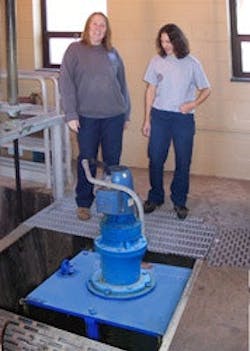Protecting Equipment from Abrasion, Clogging
The Pottstown, Pa., wastewater treatment plant handles the wastewater generated by 15,000 area homes, commercial businesses and industrial sites located in the borough of Pottstown and three nearby townships. The facility is rated for 15.6 million gal per day (mgd) and treats an average sewage flow of 7 mgd.
The plant uses a multi-step treatment process to purify the wastewater so it can be safely returned to the environment. Proper treatment of the influent remains an essential first step. By reducing plastics, rags, wood and other incoming solids to fine bits, downstream pumps and other equipment are protected from abrasion and clogging.
“That [disintegrator] was part of the original plant upgrade,” said Brent Wagner, the plant’s superintendent. “Over the years, it has been rebuilt several times but is still operational.”
The two units are installed in channels at the headworks, with a bar screen in front of each one. Once the solids are finely ground and screened, the wastewater flows into a grit system where centrifugal force removes the grit and pulls it to the bottom. The water passes into a pre-aeration tank, gets oxygenated and flows to an aeration tank, where it mixes with microorganisms for treatment. A clarifier settles the organisms and takes the cleared water off. The water is chlorinated and then returned to the Schuylkill River.
Wagner has some reservations about the way sludge is handled. “Sixty percent of our solids handling is exterior sludge,” he said. “We currently send all of those solids to a landfill. With concerns about the long-term effect on the environment, this doesn’t make sense. Hopefully, by the beginning of next year, the sludge will be recycled.”
In the meantime, the Dimminutor remains the grinder of choice. “We like the units. We have had no problems with them. They do what they are designed to do,” Wagner said.
